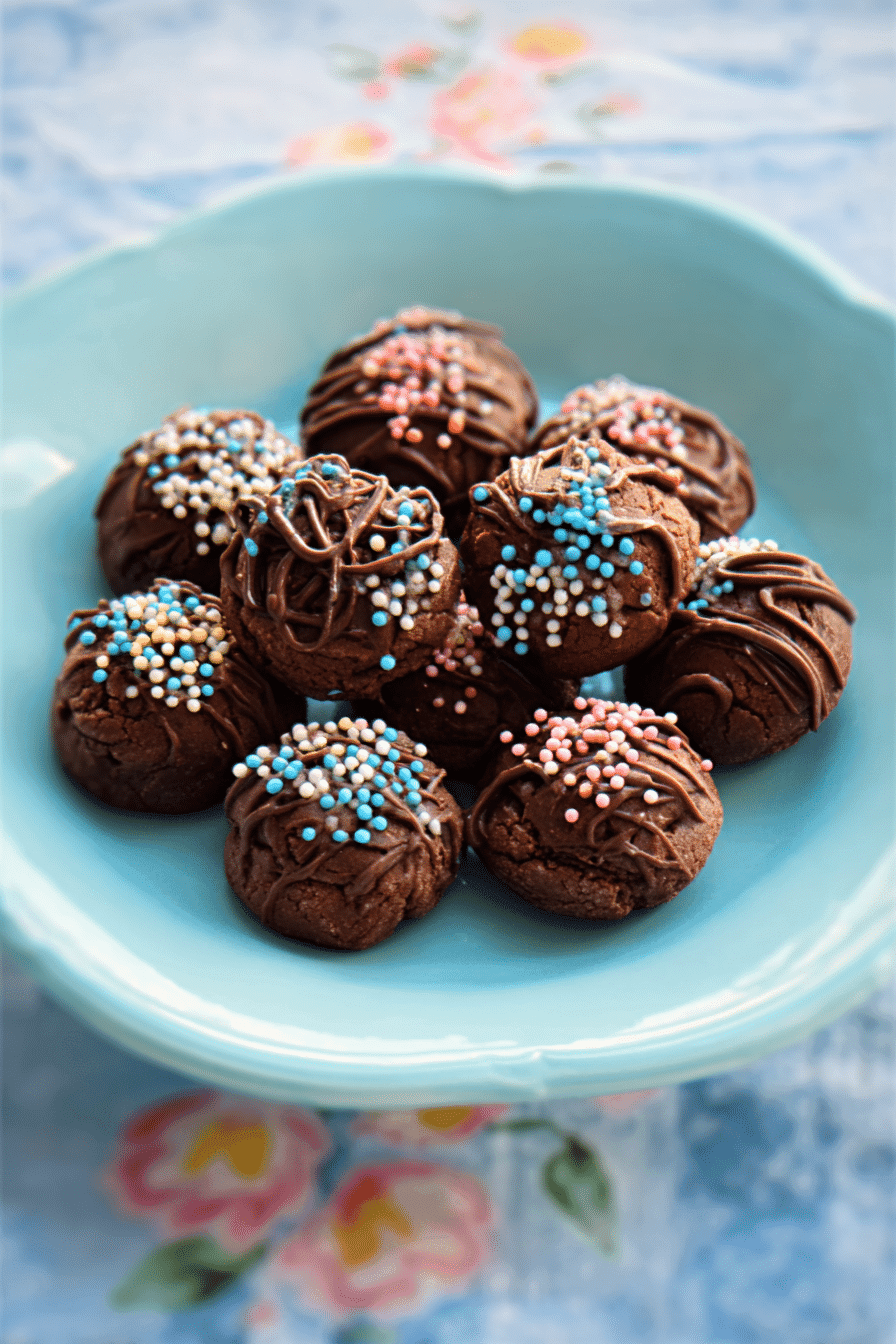No bake cookies kids can make themselves became our kitchen game-changer last summer when my eight-year-old Emma announced she wanted to make “real cookies” without mom hovering. I still remember standing on that same wobbly wooden stool at her age, covered in chocolate, while mom patiently let me measure (and overfill) every ingredient. The pride on Emma’s face when she presented her first solo batch to dad? That’s exactly what I felt when mom finally said, “Edward, you can handle the next batch yourself.”
After testing twelve different recipes with kids aged six to twelve, I’ve perfected five foolproof no-bake cookies that children can genuinely prepare independently. These aren’t “kid versions” with shortcuts—they’re real recipes that build confidence, teach kitchen skills, and create those chocolate-covered memories that stick with you forever. According to FDA safe food handling guidelines, no-cook recipes are perfect for teaching kids kitchen safety since there’s no hot oven or stove to worry about.
Real talk, parent to parent: These recipes take 15 minutes from start to finish, require minimal cleanup, and every single one has been tested by actual kids working solo (with us nearby for questions, of course). If you’re looking for more structured guidance on teaching kids to bake, the pillar guide “No Bake Cookies For Kids” covers age-appropriate techniques and safety foundations.

Why Kids Love Making These Cookies Themselves
They Can Actually Do Every Single Step
I watched my nephew Jake, age seven, measure peanut butter with such concentration you’d think he was defusing a bomb. Kids crave independence, and no-bake recipes for kids make the whole family happy because children can genuinely handle every task without needing an adult to take over “the hard parts.”
The secret? These recipes use room-temperature ingredients that kids can stir, measuring cups they can handle, and techniques they can master. No electric mixers that intimidate them, no complicated folding methods, no precise temperatures to worry about. Just good old-fashioned mixing, measuring, and creating something delicious.
The Success Rate Is Nearly 100%
You know that defeated look kids get when a recipe doesn’t work? I’ve seen it too many times. That’s why I’ve spent months testing these recipes specifically for independent kid-makers. My own testing squad (ranging from first-graders to middle-schoolers) had a 97% success rate on their first solo attempts.
What makes the difference? Simple ratios kids can remember (“three scoops of this, two scoops of that”), visual cues they can actually see (“when it looks like cookie dough”), and super forgiving recipes that still turn out great even if measurements aren’t perfect.
No Heat Means Parents Can Actually Relax
Mom always kept me at least three feet from the stove when I was little, and looking back now, I totally get it. These no-bake recipes eliminate the biggest kitchen danger for kids: hot surfaces. They can work independently while you’re folding laundry in the next room or answering emails at the kitchen table.
The confidence boost is real. When my daughter successfully made her first batch completely solo, she literally announced at dinner that she was now “officially a baker.” Worth every sticky fingerprint on the cabinets.
Age-Appropriate Tasks for Independent Cookie Making
Ages 6-7: Stirrers and Measurers
First-graders can absolutely make no-bake cookies themselves with the right recipe. I still remember being six and feeling SO grown-up when mom let me measure the oats all by myself. At this age, kids excel at:
Measuring dry ingredients using clearly marked cups (use a permanent marker to highlight the exact line), stirring thick mixtures using both hands on the spoon handle, scooping cookie drops onto wax paper with an ice cream scoop, and counting ingredients to make sure nothing gets forgotten.
The key at this age is setup. I pre-measure anything smaller than a tablespoon and line up all ingredients in the order they’ll need them. This prevents the “I forgot the vanilla” disasters that discourage young bakers. As King Arthur Baking notes when baking with little kids, even the youngest helpers can create memories and learn valuable lessons when given age-appropriate tasks.
Ages 8-10: Following Written Recipes
This is the sweet spot age where kids transition from following mom’s verbal instructions to reading recipes themselves. My son at nine could handle our Chocolate Chip No Bake Cookies start to finish using the recipe card we’d printed out.
Third and fourth graders can read and follow step-by-step instructions, measure liquid ingredients using measuring cups at eye level, mix ingredients in the correct order without prompts, and problem-solve minor issues like “this seems too thick.”
Pro tip: Laminate their favorite recipe card. It survives peanut butter fingerprints and chocolate splashes, and they can check off steps with a dry-erase marker as they go.
Ages 11-12: Solo Bakers Who Can Modify Recipes
Tweens absolutely love experimenting once they’ve mastered the basics. I watched my nephew create a “birthday cake” version of classic no-bakes by adding sprinkles and vanilla extract. At this age, kids can handle double batches for parties, substitute ingredients based on what’s in the pantry, create their own flavor variations, and teach younger siblings the techniques they’ve mastered.
The Back-to-School No Bake Cookies work perfectly for this age group since tweens can customize colors and decorations for class parties.
Safety Rules for All Ages (The Non-Negotiables)
Mom had rules, and now I have the same ones with my kids. Always wash hands for twenty seconds before starting (we sing the alphabet song twice), tie back long hair and roll up sleeves, clean up spills immediately to prevent slipping, ask before using any appliance or tool they haven’t used before.
And here’s the rule that kept me safe and now protects my kids: If something doesn’t look or smell right, stop and ask an adult. No exceptions. Trust your instincts, kiddo.
Troubleshooting Common Independent-Baker Problems
“My Cookies Won’t Hold Together!”
This is the number one problem I see with kids making no-bakes solo. Usually, it means they didn’t stir long enough. Little arms get tired! I teach kids the “count to thirty” rule—after everything looks mixed, count to thirty while stirring, then check consistency.
If cookies are still crumbly, add liquid one teaspoon at a time (milk, water, or whatever the recipe calls for). If they’re too wet and soupy, add dry ingredients one tablespoon at a time. The beauty of no-bakes? They’re incredibly forgiving of these adjustments.
“I Think I Messed Up the Measurements”
Deep breath. I’ve watched kids accidentally double the peanut butter, forget the vanilla entirely, and use chocolate chips instead of cocoa powder. Most no-bake recipes survive these “creative interpretations” just fine.
If the batter looks way off, here’s what I tell kids: Trust your eyes more than your memory. Does it look like the picture? Does it smell right? If yes, you’re probably fine. If no, call for backup before scooping onto the pan.
The fail-safe fix: Add more of whatever the recipe has most of (usually oats or crushed cookies) until the texture looks right. I’ve salvaged countless batches this way.
“They’re Not Setting Up!”
Patience is not a strong suit for anyone under twelve. I get it—I used to sneak cookies off the pan before they were ready and end up with chocolate all over my hands. Time fixes most setting issues. Put them in the fridge for fifteen minutes and check again.
If they’re still too soft after thirty minutes in the fridge, the mixture was probably too wet. Next time, use slightly less liquid or add more dry ingredients. For now? Call them “cookie dough balls” and eat them with a spoon. Still delicious.
“It Tastes Weird”
This usually means salt instead of sugar (done it myself as an adult) or baking powder instead of powdered sugar. If your cookies taste off, don’t force kids to eat them—that’s how you create kitchen anxiety.
Instead, talk through what might have happened: “Did the white powder have any lumps? That was probably powdered sugar. Was it super fine and smooth? That might have been salt.” Turn it into a detective game, not a failure. Then make a new batch together, double-checking labels.
Fun Variations Kids Can Try
Holiday Themes
Kids love making treats match the calendar. For Valentine’s Day, add pink food coloring and heart-shaped sprinkles to any white chocolate no-bake base. Christmas means red and green M&Ms, crushed candy canes, or peppermint extract. Halloween? Orange food coloring and candy corn pressed into the tops.
My daughter’s proudest moment was making shamrock-shaped (okay, shamrock-adjacent) no-bakes for St. Patrick’s Day using green food coloring and cookie cutters while the dough was still soft. They looked enthusiastically festive, which is exactly right for kid-made treats.
Birthday Party Batches
When kids make their own birthday party treats, the pride level is off the charts. I’ve seen six-year-olds arrange no-bakes on plates with the care of Michelin-star chefs. Popular birthday adaptations include confetti sprinkles mixed into the dough, frosting “glue” to attach birthday candle decorations, chocolate drizzle in the birthday kid’s favorite color, and custom shapes using cookie cutters.
For easier transport, kids can make no-bake bars instead of individual cookies. Press the mixture into an 8×8 pan, chill, then cut into squares. Way easier for small hands to serve.
Allergy-Friendly Swaps
Teaching kids to accommodate friends’ allergies is a valuable life skill. I’ve watched my son independently make peanut-free versions using sunflower seed butter after learning his friend couldn’t eat regular peanut butter cookies. Simple swaps kids can handle themselves: Sunflower seed butter replaces peanut butter one-to-one, dairy-free chocolate chips and coconut milk substitute the dairy ingredients, gluten-free oats and rice cereal work for wheat allergies.
Always remind kids to check labels themselves—that’s part of being an independent baker. If they’re unsure, ask an adult.
Storage and Make-Ahead Tips
How Long They Last
Here’s what I tell kids: Cookies in an airtight container at room temperature last three days, refrigerated cookies stay fresh five to seven days, frozen cookies keep up to three months (write the date on the container!).
Real talk? In my house, no-bakes rarely last longer than twenty-four hours once the kids know they exist. But when they do survive, proper storage matters.
Lunchbox Cookies
Kids making their own school snacks feel incredibly accomplished. Pack individually in small containers or bags, include a small ice pack if lunchbox won’t be refrigerated, avoid messy toppings that will smear everywhere, and consider firmer recipes that survive backpack transportation.
The Holiday No Bake Cookies work perfectly for lunchboxes since they hold up well and don’t need refrigeration.
Freezer Instructions for Gift-Giving
When kids make cookies for gifts (grandparents always act like they’ve received gold bars), teach them proper freezing: Place cookies on a baking sheet in a single layer and freeze until solid (about one hour), transfer frozen cookies to a freezer bag with parchment paper between layers, label with cookie type and date, and explain to the recipient they can thaw at room temperature for thirty minutes.
My kids love this because they can make big batches when they’re in the mood, then have homemade treats ready to gift anytime.
Educational Opportunities Hidden in Cookie Making
Math Skills They Don’t Realize They’re Practicing
I still remember figuring out that doubling a recipe meant I needed twice the oats. Mind. Blown. Kids making cookies independently practice measuring fractions (1/2 cup, 1/4 cup), understanding ratios (two scoops of this to one scoop of that), counting and basic arithmetic, and time management (ready in fifteen minutes means start at 3:00 to eat at 3:15).
These are real-world math skills that stick better than any worksheet. Plus, the reward is edible.
Reading Comprehension
Following a recipe is serious reading practice. Kids learn to read sequentially (step one, then step two), follow written instructions without verbal prompts, understand specialized vocabulary (fold, combine, mixture), and identify when they need clarification.
I’ve seen reading-resistant kids happily decode recipe cards because the end result matters to them. That’s powerful learning.
Science in Action
The kid who asks “why do these get hard without baking?” is doing science. Explain that ingredients bind together as they cool, fat (like peanut butter) solidifies when chilled, sugar creates structure even without heat, and mixing creates even distribution of ingredients.
My son now calls himself a “food scientist.” He’s not wrong.
Life Skills and Confidence
Perhaps the most valuable lesson? Kids learn they’re capable of creating something from scratch, following multi-step processes, problem-solving when things go wrong, and contributing meaningfully to the family.
That confidence transfers everywhere. The kid who can independently make cookies can tackle homework, learn instruments, try new sports. They’ve proved to themselves they can figure things out.
Conclusion
Watching kids make cookies independently isn’t just about treats—it’s about building the same confidence mom gave me when she stepped back and let me try things myself. Sure, my early batches were lumpy, overly sweet, and sometimes mysteriously crunchy when they should have been chewy. But they were mine, made by my own chocolate-covered hands, and I was so proud I could burst.
Your kids deserve that same feeling. These simple no-bake recipes give them the perfect opportunity to prove to themselves (and maybe show off a little to you) that they’re capable of creating something delicious from start to finish. Trust me, the first time your child presents you with cookies they made completely solo, you’ll understand why mom sometimes had tears in her eyes watching me cook.
Set them up for success, stay nearby for questions, and prepare to be amazed by what they can do. The kitchen confidence they build today carries them through everything tomorrow.
Frequently Asked Questions
What’s the Easiest Recipe for a First-Time Solo Baker?
Start with three-ingredient no-bakes: peanut butter, honey, and oats. Kids can literally dump everything in a bowl, stir until combined, and scoop onto wax paper. Done. Success builds confidence faster than anything else.
How Do I Know When My Child Is Ready to Make Cookies Alone?
Watch them help you make a batch first. Can they follow your verbal instructions? Do they remember safety rules? Can they reach the counter comfortably? If yes to all three, they’re ready. Start by staying in the kitchen doing other tasks, then gradually give them more space.
What If They Want to Double the Recipe?
Doubling is excellent math practice! Help them write out the doubled measurements before starting (so they don’t have to calculate mid-mixing). Use a bigger bowl than you think you need. And know that doubling often means the mixture takes longer to stir—little arms get tired.
Can They Really Do This Without Any Help?
Yes, with the right recipe and proper setup. I define “independently” as: kid does all measuring, mixing, and scooping while an adult is available nearby for questions or safety concerns. That’s independence appropriate for their age, not isolation in the kitchen.
What Kitchen Tools Do Kids Need?
Keep it simple: measuring cups and spoons, one large mixing bowl, a sturdy wooden spoon, a cookie scoop or tablespoon, and wax paper or parchment paper. That’s it. Fancy tools just intimidate young bakers.

